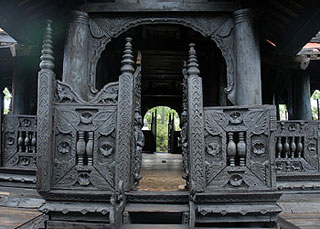Inwa was formerly known as Ava and it is located 21km from Mandalay. Inwa was also known as Yadana Pura. It was first founded as a capital by King Thado Minbya in 1364 A.D. It is the confluence of the Ayeyarwaddy & Myint Nge rivers. But the king had a canal dug to join the Myint Nge and Myint Tha rivers thus cutting off the capital as an island. safe from enemy attacks. As successive kings ruled the war with King Raza Darit of Bago for many years. the Shan chief Thohan Bwa took the advantage and overran the capital. Gradually the kingdom grew weaker and finally it became a vassal to the Taungoo Empire. Later kings shifted the capital from Inwa back and forth many times until King Bayint Naung’s son King Nyaung Yan re-established his capital at Inwa in 1596 A.D. It continued to be capital till 1782 when Bodawpaya moved the capital to Amarapura. But his son King Bagyidaw moved his capital back to Inwa. It was destroyed by the earthquake of 1838.


The ruins of the palace. the massive fort walls and moat can still be seen of the splendour of the past when it had been the capital for more than four and half centuries. Inwa lies south of Mandalay and can from there in only 30 minutes of drive be attained. This old king city was long time capital of Oberburma. The foreign country was at present well-known Myanmar as the Kingdom of Ava.The king palace at that time does not exist any longer. however still the Nanmyint awake tower. From 27 meters height of bird perspective one can examine the range of the historical place. Numerous pagodas. temple and monasteries outlasted however Inwas’ eventful past. The monastery Maha Aung Myay Bon Zan built with brick and stucco is particularly interesting. It was established to 1818 by the queen Me Nu for the royal abbot at that time U Po.
On the road to Sagaing. just before you reach the Inwa bridge. there is a road branching east ward. The Inwa bridge crosses the Ayeyarwaddy River. This road leads to a ferry station where you can cross the Myittha river to reach Inwa.
Interesting Places
MAHA AUNG MYE BON ZAN MONASTERY (ME NU OAK-KYAUNG)


The Maha Aung Mye Bonzan. well known as Me Nu Oak-kyaung (Brick Monastery). was built in 1822 by Nanmadaw Me Nu. Chief Queen of King Bagyidaw. for the royal abbot Nyaunggan Sayardaw U Po. then offered to the 2nd Nyaunggan Sayardaw U Bok. I was also damaged by the earthquake of 1838 but was repaired in 1873 by Sinphyumashin. the daughter of Me Nu and a queen of King Mindon. This monastery is one of the finest specimens of Myanmar architecture during the Konbaung Period (19th century). Its architecture is in simulation of wooden monasteries with multiple roofs and a prayer hall of seven-tiered superstructure.
THE GRAND BARGAYA MONASTERY


The name Bargaya is a Mon word. It literally means Khayebin Kyaung. The Bagaya monastery was built on the southwest of Inwa palace on 1593. During Hsin Phyu Shin’s reign (1763-1776. Atwinwun Mahathirijeyathankhya. town officer of Magwe built the monastery in the Bagaya monastic establishment and dedicated to Shin Dhammabhinanda. During King Bagyidaw (1819-1837) the great fire broke out to Kontha quarter. to the south of the palace on 15 April 1821 and Hluttaw. tooth relic tower. watch tower and to northern gate caught fire and seemed that the Bagaya monastery was burnt in the fire.The government tried to reconstruct in 1992. It intends to build a ( gadhakuti) special shrine for the use of Buddha image and Pitaka scriptures. So it put the new Brick building in the place of the old monastery. It was recorded that the monastery was constructed on the model of the old monastery.
The grand Bagaya monastery. decorated with splendid Myanma architectural works. is in the ancient city of Innwa.King Bagyidaw of Innwa era built the Bagaya monastery at the confluence of the Ayeyawady and the Myitnge rivers in 1196 Myanma Era.


The site of the monastery is about (11) miles from the Mandalay City. The grand Bagaya Monastery has a three-tiered roof and its adjacent religious lecture hall. in the eastern side of the monastery. has a seven-tiered roof. The monastery has (267) teak posts. The largest teak post is (9) feet in circumference. The post is (60) feet high. The monastery is (118) feet long and (103) feet wide. The monastery has tour brick stairs.
The entire building of the monastery is decorated with carvings. floral arabesques. the ornamentation with curved figurines and the reliefs of birds and animals as well as small pillars on the wall decorated with tunnery. the artistic works of Innwa Era. Large teak of the doors monastory are also beautifully dsigned with sculptures and reliefs.
There is a reverential statue on a throne in the Marabin or a large hall with its partition reaching from the floor to the ceiling of the monastery. The statue was sculptured with the handiwork of Innwa Era. The grand Bagaya monastery is still existing today in its original form. All the Myanmar nationals can be proud of the splendid monastery which is like an ancient arts museum.
WATCH TOWER (NAN MYINT)


The watch tower which is about 90 feet (30 m) high is a solitary masonry building that remains of Bagyidaw’s palace built in 1822. Owing to the earthquake of 1838. only the lower part was left but it was restored as its original structure. The watch tower is one of the examples of Myanmar architectural style of early 19th century.
